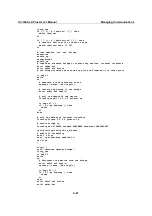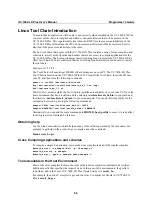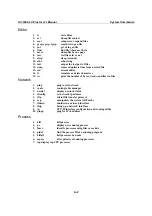
UC-7400-LX Plus User’s Manual
Programmer’s Guide
5-2
Before Programming Your Embedded System
Caution When Using File Systems
We recommend placing only your programs into the on-board NOR Flash. For the log data
generated by your programs, please store them into an external storage such as Compact Flash or
Network File System. The latter has larger space than the former. In addition, it is easier replacing
a full or damaged Compact Flash than an on-board NOR Flash.
A NOR Flash has a life cycle of 100,000 write operations in block (128KB) level. It does not
support BBM (Bad Block Management). A CF card has its life cycle too. But most of them are
made of NAND Flash, their hardware controllers implement BBM. This feature allows FAT to skip
bad blocks if there are. Furthermore, the memory space of a CF card is much larger than that of the
NOR Flash. Cautiously utilizing this space will make sure its life cycle would not be exceeded.
When creating a file for storing log data, your program is suggested to create a large empty file
(eg., 30MB) and then evenly writes data over the space. When reaching the end of the space, the
program rewinds the write operations. As a result, the number of write operations on each block
reduces.
Using RAM File System Instead of Flash File System
Though data in the RAM file system will be wiped out after a power off, this file system has
several advantages over the Flash file system. They include faster read/write access and having no
life cycle issue.
For a timely important application that relays data back to the host directly, please write the
necessary log data into the RAM file system. After the host accesses the data, the application
erases the area for further use.
The embedded computer has limited resource, the designers should determine if storing data in a
file system is really a must or not. If it is necessary, choose the most proper file system.
Flash Memory Map
Partition sizes are hard coded into the kernel binary. To change the partition sizes, you will need to
rebuild the kernel. The flash memory map is shown in the following table.
Address Size
Contents
0x00000000 – 0x0005FFFF
384 KB
Boot Loader—Read ONLY
0x00060000 – 0x001FFFFF
1.625 MB
Kernel object code—Read ONLY
0x00200000 – 0x00DFFFFF
14 MB
Root file system (JFFS2)—Read ONLY
0x00E00000 – 0x01FCFFFF
17.75 MB
User root file system (JFFS2)—Read/Write
0x01FC0000 – 0x01FDFFFF
128 KB
Boot Loader configuration—Read ONLY
0x01FE0000 – 0x01FFFFFF
128 KB
Boot Loader directory—Read ONLY
















































